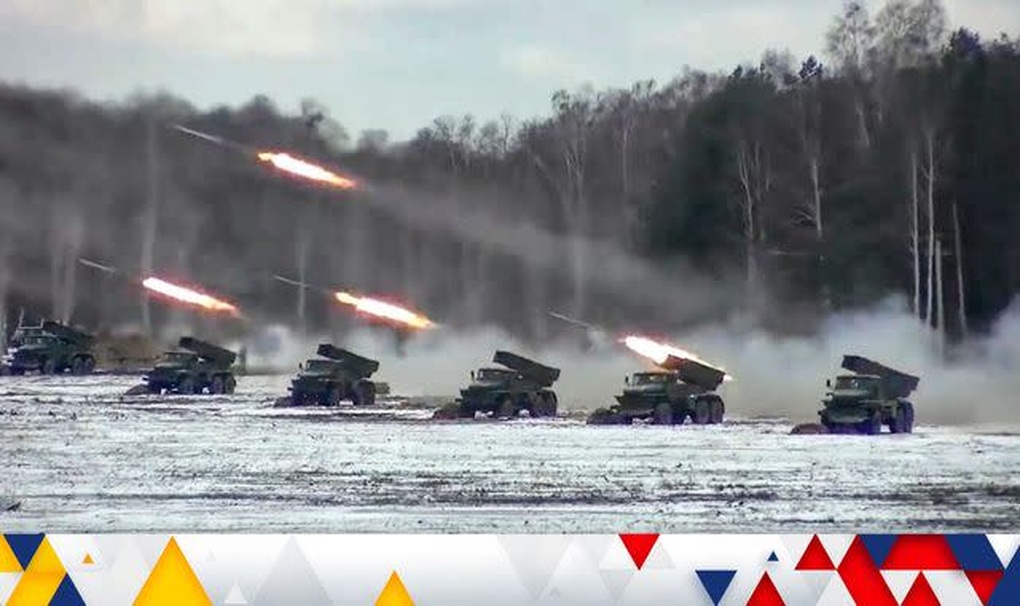
Russian BM-21 Grad rocket launcher fires at Ukrainian target (Illustration: Sky News).
Russia breaks Kiev's defense line in Avdiivka
General Oleksandr Tarnavsky, commander of Ukrainian forces in the south, said the Russian army had officially begun the third wave of the attack on Avdiivka with a thrust in the southeast direction.
Russia took control of the refinery station at the southeastern corner of Avdiivka after a wider breakthrough in the northwest direction, resulting in the breach of defenses on both flanks.
"The Russians have begun the third wave of active operations as part of the Avdiivka offensive," the general said.
Pro-Kiev military analysts updated battle maps showing Russian forces heavily attacking the city from the southeast.
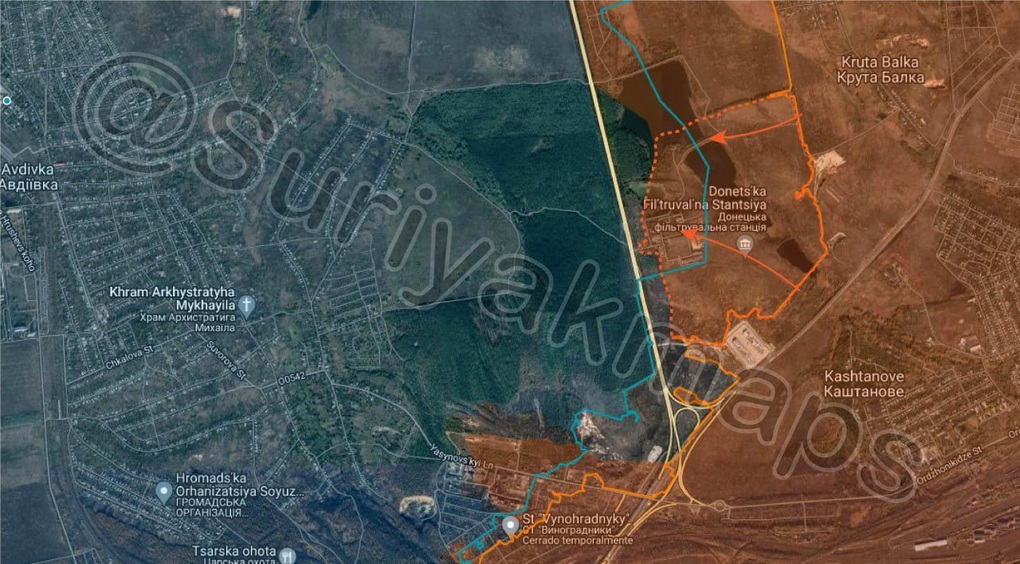
Map of the Ukrainian war in the south of Avdiivka as of November 23 (Photo: Suriyakmaps).
According to the Geroman channel, on the northern flank of Avdiivka, Russia gained several new positions, covering the eastern outskirts of the village of Steponoye on both sides.
On the southern flank, Russian troops are advancing on the Vinogradniki settlement, successfully taking control of the Donetsk refinery.
In the Gorlovka area, several Ukrainian infantry groups attacked towards Mayorsk but were repelled by the Russians. However, Kiev forces have increased artillery bombardment of Gorlovka, and the Russians are trying to hunt down enemy firing points and artillery positions to reduce losses.
Sources close to Kiev say that Chief of the General Staff of Ukraine Zaluzhny believes that it is pointless to send reserve troops into Avdiivka, as it was in Bakhmut before. But Kiev is clearly not going to abandon the city.
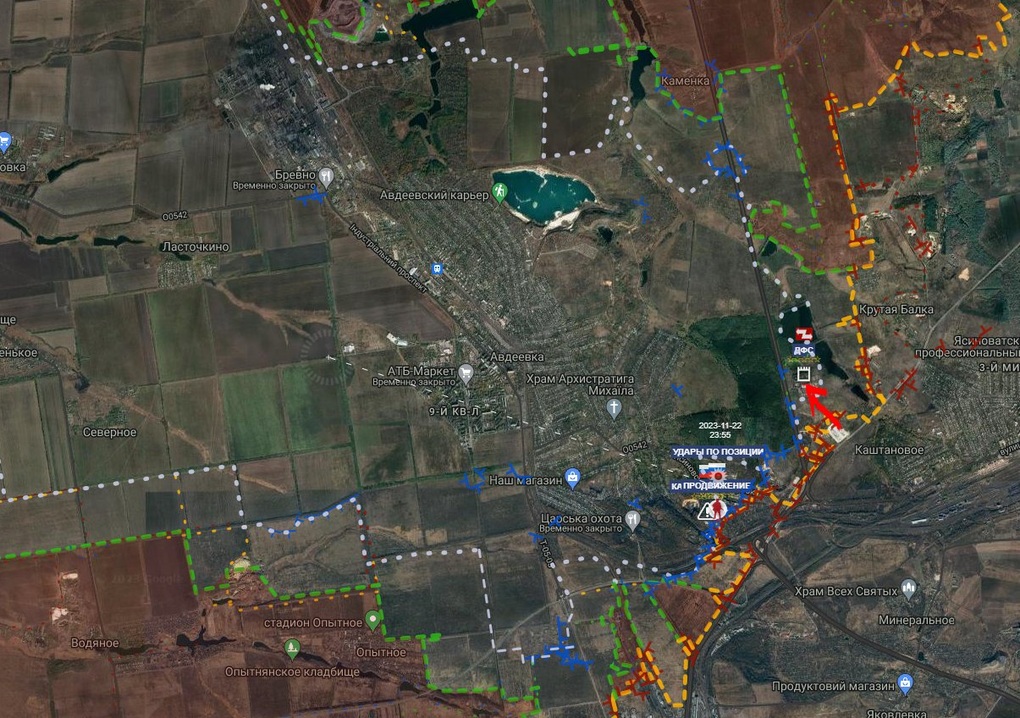
Map of the Ukrainian war in Avdiivka as of November 23 (Photo: Geroman).
Russia continues to attack Avdiivka
The Kyiv Post reported that Moscow launched the third large-scale infantry attack on the enemy's key stronghold on November 23, causing many casualties.
Kiev soldiers defending Avdiivka posted on social media that they had a strange feeling watching the Moscow forces regroup, a relative calm before the storm. By Thursday morning, November 23, that storm had arrived.
Russia stops three-pronged attack, continues attack near Avdiivka
Ukrainska Pravda reported that the evening report of November 23 of the Ukrainian General Staff said that in the past 24 hours, Russian troops did not conduct offensive operations in the direction of Limansky, Zaporizhia and Shakhtarsky but continued to attack in the direction of Avdiivka, with 52 clashes.
The operational situation in eastern and southern Ukraine remains difficult, the report said.
In the Kupyansk direction, the enemy with air support attacked in the Sinkovka area of the Kharkov region, where the defense forces repelled two attacks.
In the direction of Bakhmut, Russia conducted unsuccessful offensive operations near Klishchiivka and Andriivka in the Donetsk region. Ukraine repelled 10 attacks.
In the direction of Avdiivka , with the support of the air force, Moscow forces attacked in the east of Novokalinovo, Avdiivka and Pervomaisky, Donetsk region but failed. Here, Kiev forces repelled 18 attacks.
In the direction of Marinka, the enemy, with the support of the air force, launched unsuccessful attacks in the Marinka and Novomikhailovka areas of the Donetsk region, where Kiev forces repelled 11 attacks.
At the same time, Kiev continued to conduct offensive operations in the direction of Melitopol and Bakhmut, causing losses to Russian forces in terms of manpower and equipment, exhausting the enemy along the entire front line.
Our soldiers then took up positions on the left bank of the Dnieper, Kherson region. They continued to fire at the enemy.
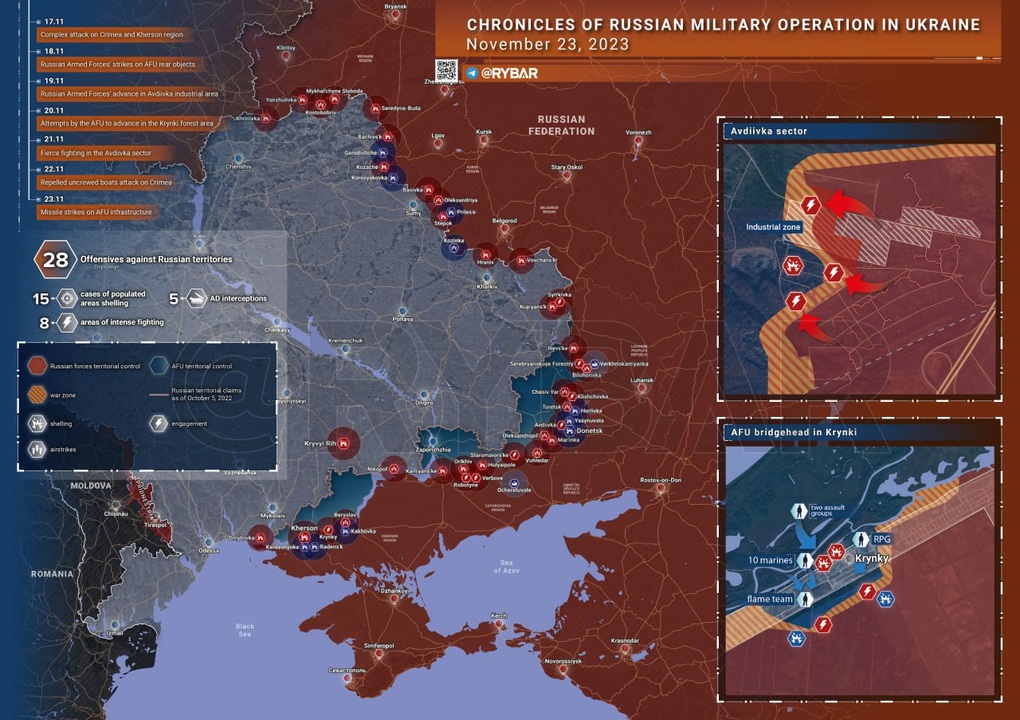
Map of the Ukrainian war as of November 23, with developments in the Avdiivka area in the upper right corner (Photo: Rybar).
President Putin visits Belarus
Russian President Vladimir Putin has visited Belarus to take part in the Collective Security Treaty Organization (CSTO) summit in Minsk, the Kremlin press service announced on November 23, Kyiv Independent reported.
The CSTO is a military alliance between Russia, Armenia, Kazakhstan, Kyrgyzstan, Belarus and Tajikistan, established in 2002.
The meeting was scheduled to discuss "further improvement of the collective security system".
Putin last made an official visit to Belarus in December 2022. In the past few months, the Russian president has traveled to Kazakhstan, China and Kyrgyzstan.
Russian parliament passes budget with record military spending
The Russian parliament has approved a budget for 2024 that will increase military spending to more than a third of total government spending, the independent Russian media outlet Meduza reported on November 23, Kyiv Independent reported.
Combined with funding for domestic law enforcement agencies, this figure rises to 40%.
According to Meduza, state spending on Russia's military sector will exceed social payments for the first time.
The West cannot agree on artillery shell production.
The Kyiv Independent reports that the US and Europe are arguing over who will send artillery shells to Kiev and whether that will be enough.
Countries that have promised to supply artillery are either insisting the problem isn't really that bad or are divided over whose factories will fill lucrative orders for the hundreds of thousands of artillery shells and mortar rounds Kiev desperately needs.
Sabrina Singh, Deputy Press Secretary of the US Department of Defense, said at a press briefing that recent reports of a sharp decrease in US artillery shell deliveries to Kiev following the Pentagon's decision to prioritize shipments to Israel were inaccurate.
Asked by Voice of America to comment on reports that deliveries of 155mm artillery shells to Kiev have dropped by more than 30 percent since the Israel-Hamas war began, and that Ukrainian officials have confirmed the decline, Singh replied:
"Well, I would refute that assertion. We have been able to provide Kiev with what they need in the counteroffensive and will continue to provide what they need as we go into winter. We can do that and we can provide Israel with what they need to defend themselves in their fight with Hamas. We feel confident that we can do both of those things and we will continue to do both of those things."
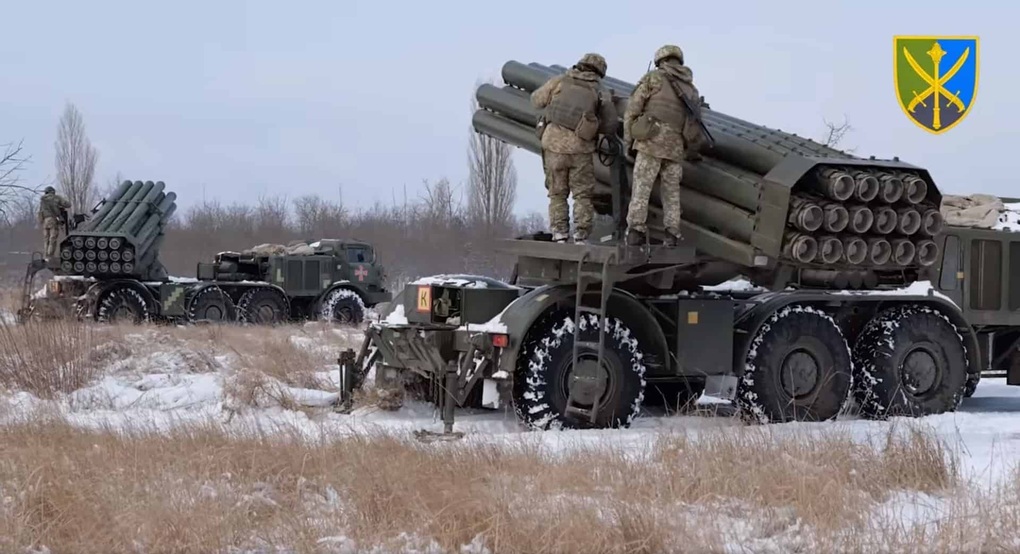
Ukrainian BM-27 Uragan multiple launch rocket systems (Photo: Ukrainian Ministry of Defense).
President Zelensky admitted: "Our deliveries have decreased. They have actually slowed down... It's just that people are scrambling to fill (the stockpiles) for themselves. This is life... I'm not saying this is positive, but this is life and we have to protect what is ours."
Most military analysts estimate that the Ukrainian army is currently equipped and operates about 650-700 NATO standard artillery systems, of which about 500 systems fire 155mm artillery shells and 200 systems use 105mm artillery shells.
According to open sources, the AFU fires 2,000 to 3,000 NATO standard rounds in a typical day of combat and would need at least two or three times that number to fully control a 1,500km front line.
Actual artillery shell usage and artillery shell stocks are AFU military secrets.
On November 17, both Latvian President Edgars Rinkevics and Ukrainian Foreign Minister Dmitro Kuleba said that EU arms manufacturers were not confident in their ability to supply them. Kiev had to look for alternative sources of NATO-standard artillery shells and that waiting in Europe was dangerous.
At the same time, EU leaders are arguing over which factory will produce how many shells. Meanwhile, the Kremlin has ordered and the Russian army has received at least a million shells by express rail from North Korea.
The US's ability to fill the shell gap in Europe is also in doubt, Ms. Singh admitted, because Washington's military aid to Kiev has almost dried up and without additional congressional approval, the weapons available to Kiev will run out.
Russia increases troops, surrounds Avdiivka on 3 sides
Despite heavy losses, Russia is sending reinforcements to the besieged town of Avdiivka in an effort to seize strategically important territory on the eastern frontline, the Ukrainian military said, the Guardian reported.
Nestled in a hollow – surrounded on three sides by Russian forces – Avdiivka has become a symbol of a brutal war in which neither side has made a decisive breakthrough in more than a year. Despite sustained losses in men and equipment, Moscow shows no signs of giving up its bid to seize the former coal hub in Ukraine’s industrial east.
Kiev has spent the past nine years building up defences and trenches to defend the city. The massing of troops towards the city marks a change in Russian tactics in the battle for Avdiivka.
In October, Moscow launched a major offensive to try to encircle Avdiivka with hundreds of armored vehicles but fell into minefields, came under attack from UAVs and anti-tank missiles.
A Western official said the Russian military lost more than 200 armored vehicles in that failed attack.
Russian tanks clear the way for infantry in South Avdiivka (Source: Blackrussian).
Kiev strives to restore sea exports
Kiev's efforts to resume seaborne exports despite Moscow's military blockade have offered a glimmer of hope to a shaky agricultural sector where loss-making producers are abandoning some land in one of the world's biggest grain belts, Reuters reported.
Access to the Black Sea is crucial if Ukraine is to preserve an agricultural sector that was the world's fourth-largest grain supplier before the conflict and in value terms accounted for half of Kiev's total exports last year.
While temporary export routes and ample supplies elsewhere have helped to reduce global food prices, which have been at record levels since last year, the strain on Ukraine’s agricultural sector has worsened as a UN-backed export deal collapsed and EU neighbours objected to road transport.
The Ukrainian grain trade association UGA estimates that the agricultural sector has lost more than $25 billion since the conflict began. So far, grain exports in the 2023-2024 season, which began in July, are 28% lower than the previous year’s volume, according to data from the Ministry of Agriculture.
A new shipping channel across the Black Sea could provide a lifeline, as it did for Ukraine's moribund steel industry.
The “humanitarian corridor” set up by Kiev’s military in late August has steadily expanded, with Kiev estimating that more than 3 million tonnes of grain have been transported so far. Its future remains clouded by military risks, with some ships hit by mines or missiles, but Ukrainian producers remain encouraged.
Source





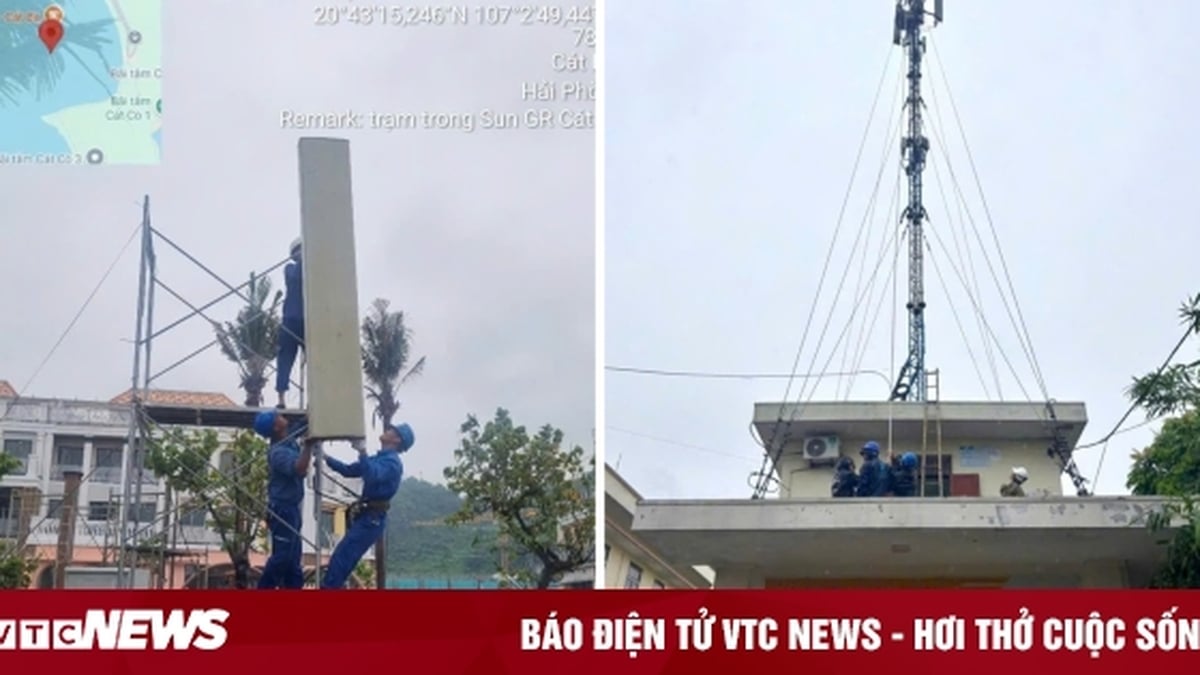




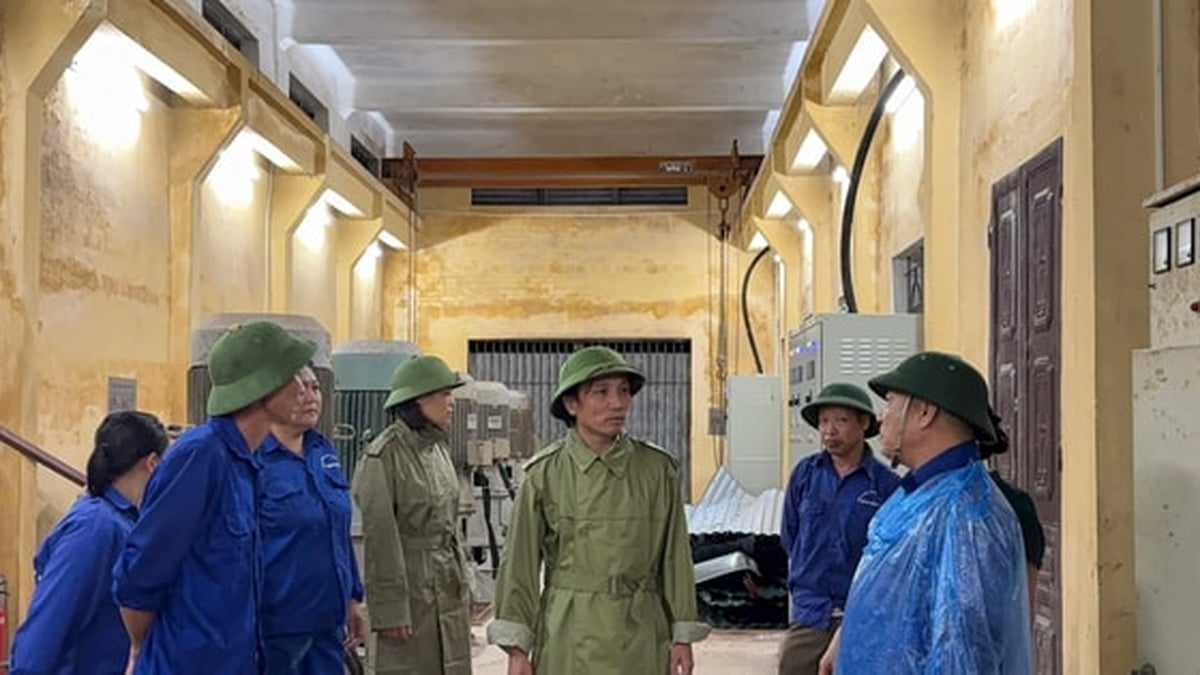











![[Photo] National Assembly Chairman Tran Thanh Man visits Vietnamese Heroic Mother Ta Thi Tran](https://vphoto.vietnam.vn/thumb/1200x675/vietnam/resource/IMAGE/2025/7/20/765c0bd057dd44ad83ab89fe0255b783)














































































Comment (0)